• KEITH BRANDON CARI-AN
(Last of Two Parts)
In Part 1, the author recounted the initiatives and actions implemented by the local government, national agencies, non-profit groups, and grassroots organizations to combat the losses brought about by the El Niño phenomenon in Negros Occidental.
In this second part of the report for Fair Finance Philippines (FFPH), the author explores the other side of the extreme effects of climate change – La Niña.
Remembering Typhoon Odette
The devastation brought by Typhoon Odette (Rai) in December 2021 was a grave wake-up call for Negros Occidental.
A total of 288,732 families and 1,144,077 individuals were affected in 408 barangays in the province, the Adventist Development & Relief Agency reported as per its rapid multi-sectoral assessment.
In the assessment, Negros Occidental logged 49 deaths, 208 injuries, and eight missing persons. A total of 270,577 damaged houses (68,816 totally/201,761 partially) and P229,195,000 estimated cost of damage were also reported in Negros Occidental, it said.
The infrastructure damage was reported at P2,384,323,000 while P5,765,132,840.46 worth of damage to agriculture was incurred.
According to the 2023-2028 Western Visayas Regional Development Plan, Typhoon Odette, along with succeeding natural calamities, exacerbated the ongoing effects of the COVID-19 pandemic on the region’s macroeconomy.
Floods in Bacolod, Negros Occidental
Post-Typhoon Odette, floods continued to plague the province, as reported by local and national media.
In a consolidated report by this author, the press covered and published articles on various weather phenomena that resulted in urban floods in Bacolod City. They covered the height and aftermath of Severe Tropical Storm Paeng (2022), Tropical Depression Agaton (2022), monsoon-driven heavy rains in 2023, heavy rainfall brought about by the intertropical convergence zone (ITCZ) in the same year, Super Typhoon Egay (2023), and Typhoon Goring (2023).
In late August 2023, at least 31 of the 61 barangays of Bacolod were either partially or submerged in floodwater due to the Southwest Monsoon (Habagat) rains, intensified by Typhoon Goring (Saola).
Among the affected barangays in the Negros Occidental capital, parts of Mansilingan, Pahanocoy, Punta Taytay, Sum-ag, Sincang-Airport, Bata, Banago, Tangub, Mandalagan, Alijis, 35, 36, 39, and 40 were first to be submerged in floodwaters.

Meanwhile, several areas in 10 cities and towns in Negros Occidental were also reported to have been flooded due to the aforementioned weather phenomena.
Severe Tropical Storm Paeng (Nalgae), which hit in October 2022, caused floods in 15 LGUs – cities of Bago, Escalante, Kabankalan, San Carlos, Silay, and Sipalay; and the municipalities of Calatrava, Candoni, Cauayan, E. B. Magalona, Hinoba-an, Ilog, Isabela, Moises Padilla, and Valladolid – and affected close to 29,000 individuals.
More than 32,600 individuals from 13 localities were affected by floods brought about by Super Typhoon Egay (Doksuri) in July 2023.
Causes of floods
The damage caused by Typhoon Goring prompted Mayor Alfredo Abelardo “Albee” Benitez to declare a state of calamity in Bacolod City in August of the previous year.
Obstructions along rivers and creeks, the accumulation of sediments in waterways originating from upland areas, and lack of interconnection of inland drainage systems were identified by the City Disaster Risk Reduction and Management (DRRM) Office, and the local government’s concerned departments as among the causes of flooding.
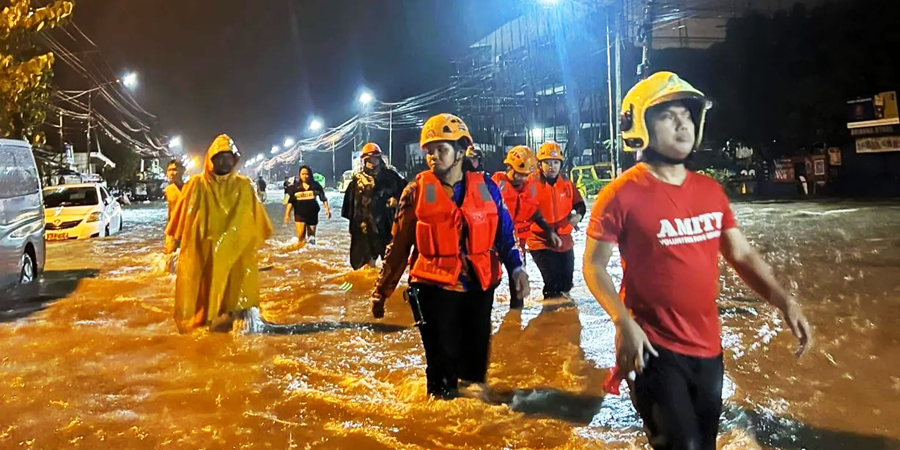
Due to these infrastructural issues, numerous barangays were also found to be at-risk.
In January 2023, the Mines and Geosciences Bureau of the Department of Environment and Natural Resources tagged the 317 barangays in Negros Occidental as flood and landslide-prone.
Of these, 56 barangays were categorized as very high risk for flooding, 56 as high risk for flooding, 20 as very high risk for landslides, and 115 as high risk for landslides.
A report from a local digital media outlet, Digicast Negros, attributed deforestation as among the contributors to flooding.
Negros Occidental, according to Forest Watch, lost 176 hectares of humid primary forest from 2022 to 2023.
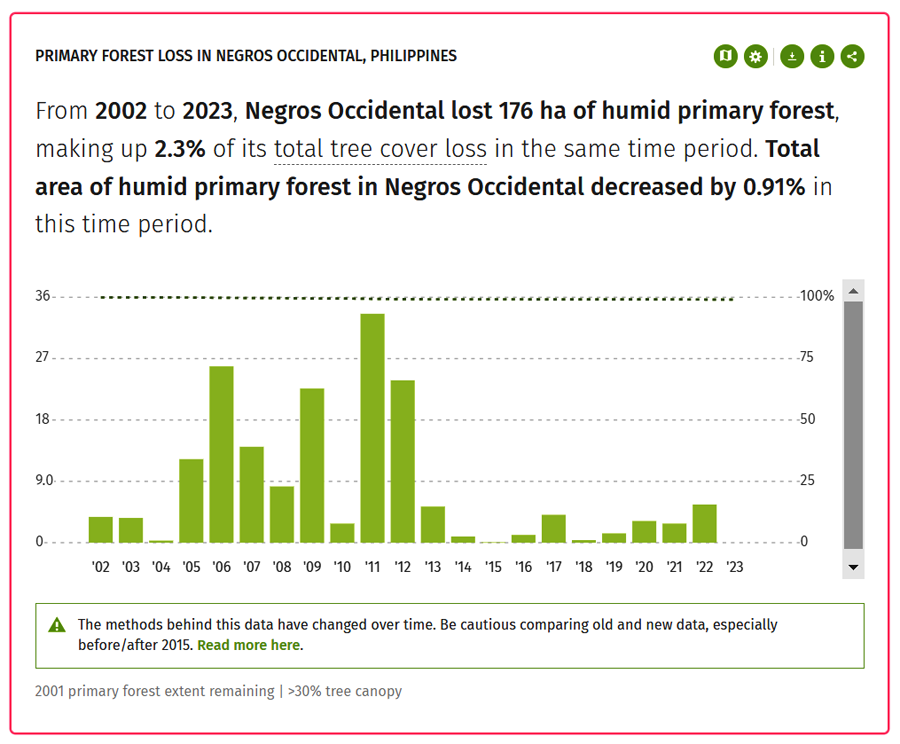
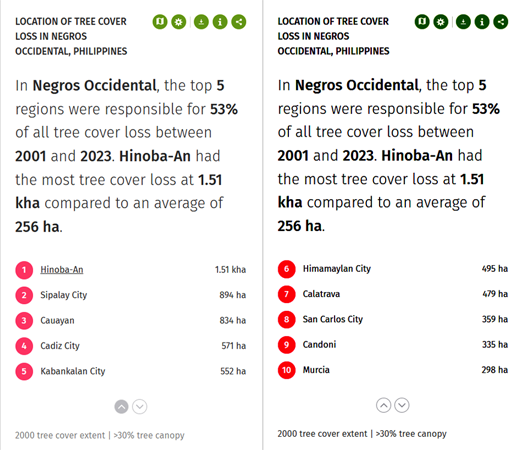
In Hinoba-an town alone, over 1,510 hectares of forest cover were deforested between 2021 and 2023. Joining the Southern Negros Occidental town are Sipalay City (894 hectares), Cauayan (834 hectares), Cadiz City (571 hectares), and Kabankalan City (552 hectares).
Even protected forest areas, essential for maintaining watersheds and weathering torrential rainfall, are not spared. One example is the Northern Negros Natural Park (NNNP) that has one of the largest forest covers in Negros Island.
Its Protected Area Management Plan for 2018-2022 period identified multiple threats, issues, and concerns at NNNP, leading to the degradation of critical habitats and resources, including limited stakeholder awareness and capacity; management and political issues; socio-economic, and cultural issues; law enforcement issues; sustainable program issues; logistics and support concerns; and disaster and risk management concerns.
The identified challenges in the NNNP bear similarities to the reported concerns and issues in other protected areas and local conservation areas in Negros Occidental.
Vulnerability to flood
The Bacolod City Disaster Risk Reduction and Management Plan for 2023-2025 classified 26,480 households as exposed to high flooding susceptibility with low to moderate risk. These are in barangays 1, 10, 12, 13, 14, 16, 2, 27, 28, 3, 31, 35, 36, 39, 40, 41, 5, 8, Banago, Singcang, Tangub, Pahanocoy, Sum-ag, and Punta Taytay.
The DRRM Plan also identified 50 structures in barangays Tangub, 12, Villamonte, 5, Mandalagan, Punta Taytay, 1, 10, 14, 16, 2, 3, 35, 40, 8, Pahanocoy, Singcang, and 13 as exposed to high flooding susceptibility with low to moderate risk. These structures included hospitals and daycare centers.
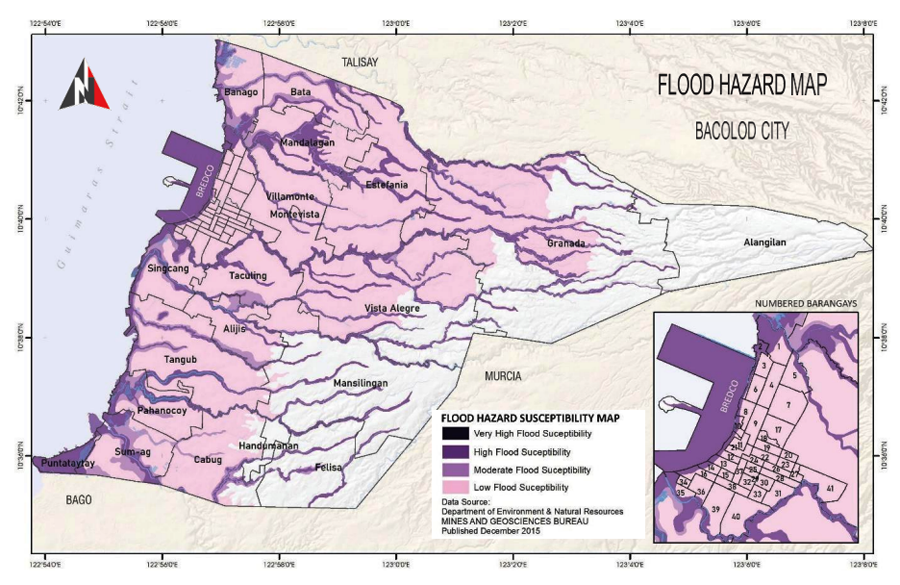
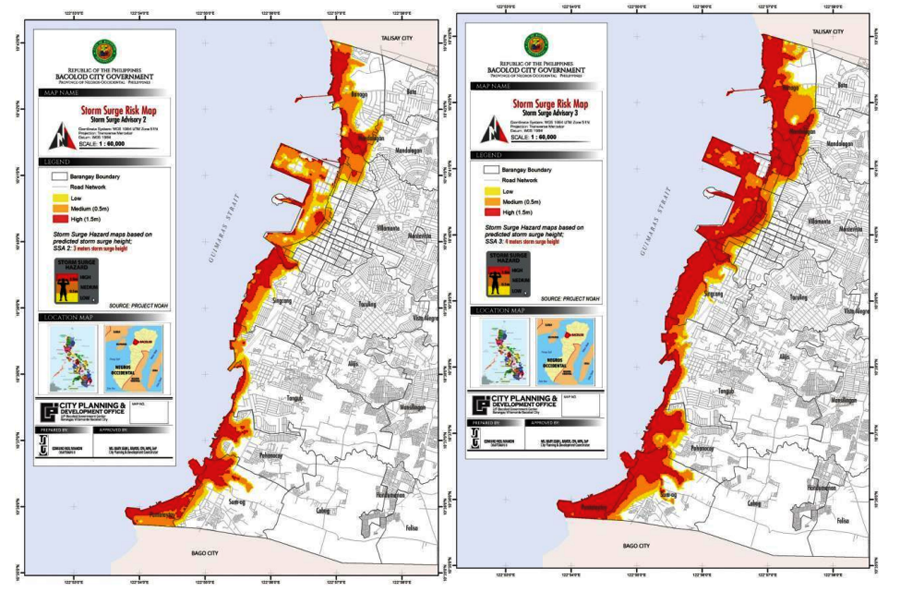
Based on the city’s flood map, areas most susceptible to floods are those close to watersheds, water systems, and coastal areas.
Likewise, coastal barangays susceptible to floods are also at high risk for storm surges. The combination of downflowing upland waters, high tide, and storm surge has also been pinpointed as cause for deeper urban floods in said areas.
While the coastal communities in Bacolod City are still vulnerable to flooding, LGUs in Negros Occidental that have communities near watersheds have employed adaptive capacities to reduce the vulnerability of these barangays.
In a 2017 study by Victor Ella, published in the Journal in Urban and Regional Planning of the University of the Philippines (UP), the barangays identified around the 35 major watersheds were assessed to be only slightly vulnerable to flood due mainly to their very high adaptive capacity index values.
Ella attributed this to having more evacuation shelters, available medical services, past flood experiences, and government programs.
Bracing for La Niña
As the El Niño phenomenon came to a close mid-2024, the Provincial Government of Negros Occidental braces for the effects of La Niña, where above average rainfall is expected.
Gov. Eugenio Jose Lacson said in a press interview on May 7 that the provincial LGU is preparing for the rainy season. Lacson further hopes for rains and not typhoons.
To prepare, three LGUs in the province are benefitting from the P293 million worth of slope protection and flood mitigation projects of the Department of Public Works and Highways (DPWH) in Western Visayas.
In Kabankalan City, the project includes the 342-lineal meter concrete slope protection along the upstream of Approach A of Ilog Bridge in Barangay Talubangi as well as the 302.4-lineal meter structure in the upstream of Approach B in Barangay Linao, the Philippine News Agency (PNA) said, citing DPWH in a report.
A riverbank slope protection project was constructed along the Binalbagan and Bacolod South Road in Barangay San Jose. The 236-meter structure fortified with steel sheet piles is designed to hold the soil in place and prevent erosion, especially during heavy rains and typhoons, the PNA report said.
Meanwhile, in San Carlos city, a P20-million sea wall, comprised of a 100-meter slope protection structure and a 210-meter wave deflector, has been constructed along the coastal community in Barangay 6, which is vulnerable to flooding and seawater overflow.
Riverside areas were also addressed by these flood control projects. In August 2023, the DPWH completed the 294.8-lineal meter structure built along the Ilog-Hilabangan River in Barangay Orong, Kabankalan City.
A 743-lineal meter stone-masonry structure on both sides of the bank at Minulu-an River will also protect adjacent properties along the waterway and ensure better management of waterflow. This project was completed in March 2023
Bacolod City isn’t far behind in its own preparations for La Niña.
Aside from the ongoing implementation of its DRRM Plan effective until next year, the city government’s Task Force Baha and the DPWH have started identifying flood-prone areas.
During an inspection in early May, the LGU and the agency identified three major flooding areas: SM City Mall at the Reclamation Area, Magsaysay flyover, and San Juan Street.
One of the strategies moving forward includes conducting a joint survey to assess the current status of rivers and creeks, and evaluate ongoing national and local road projects.
As the city experienced floods caused by the rains in late April and high tide, the LGU plans to create a master plan to map out these vulnerable areas to complement the ongoing drainage master plan project.
Preventive measures for flash floods have been laid out in Negros Occidental and Bacolod City. However, there are still gaps that need to be filled.
Although some mitigation and quick-response implements are already in place, more sound solutions from the local governments and proactive participation from its people must be encouraged while the province is still in calm before the storm. ||




